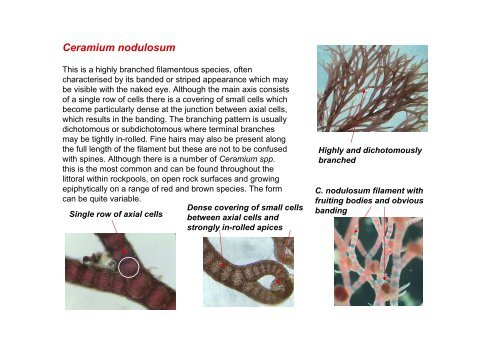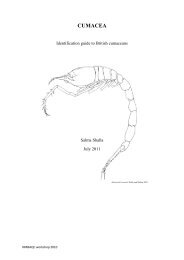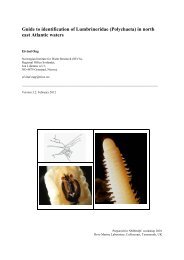s A Field Guide to the British Seaweeds - NMBAQC
s A Field Guide to the British Seaweeds - NMBAQC
s A Field Guide to the British Seaweeds - NMBAQC
Create successful ePaper yourself
Turn your PDF publications into a flip-book with our unique Google optimized e-Paper software.
Ceramium nodulosum<br />
This is a highly branched filamen<strong>to</strong>us species, often<br />
characterised by its banded or striped appearance which may<br />
be visible with <strong>the</strong> naked eye. Although <strong>the</strong> main axis consists<br />
of a single row of cells <strong>the</strong>re is a covering of small cells which<br />
become particularly dense at <strong>the</strong> junction between axial cells,<br />
which results in <strong>the</strong> banding. The branching pattern is usually<br />
dicho<strong>to</strong>mous or subdicho<strong>to</strong>mous where terminal branches<br />
may be tightly in-rolled. Fine hairs may also be present along<br />
<strong>the</strong> full length of <strong>the</strong> filament but <strong>the</strong>se are not <strong>to</strong> be confused<br />
with spines. Although <strong>the</strong>re is a number of Ceramium spp.<br />
this is <strong>the</strong> most common and can be found throughout <strong>the</strong><br />
lit<strong>to</strong>ral within rockpools, on open rock surfaces and growing<br />
epiphytically on a range of red and brown species. The form<br />
can be quite variable.<br />
Single row of axial cells<br />
Dense covering of small cells<br />
between axial cells and<br />
strongly in-rolled apices<br />
Highly and dicho<strong>to</strong>mously<br />
branched<br />
C. nodulosum filament with<br />
fruiting bodies and obvious<br />
banding




